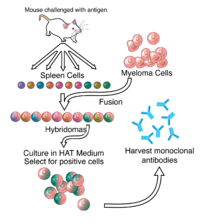
Photo from wikipedia
The biopharmaceutical market is driving the revolution from traditional batch processes to continuous manufacturing for higher productivity and lower costs. In this work, a batch mAb downstream process has been… Click to show full abstract
The biopharmaceutical market is driving the revolution from traditional batch processes to continuous manufacturing for higher productivity and lower costs. In this work, a batch mAb downstream process has been converted into an integrated continuous process with the combination of multiple techniques. For process intensification, two batch mode unit operations (protein A capture chromatography, ultrafiltration/diafiltration) were converted into continuous ones; for continuity, surge tanks were used between adjacent steps, and level signals were used to trigger process start or stop, forming a holistic continuous process. For process automation, manual operations (e.g., pH and conductivity adjustment) were changed into automatic operation and load mass was controlled with process analytical technology (PAT). A model‐based simulation was applied to estimate the loading conditions for the continuous capture process, resulting in 21% resin capacity utilization and 28% productivity improvement as compared to the batch process. Automatic load mass control of cation exchange chromatography (CEX) was achieved through a customized in‐line protein quantity monitoring system, with a difference of less than 1.3% as compared to off‐line analysis. Total process time was shortened from 4 days (batch process) to less than 24 hours using the continuous downstream process with the overall productivity of 23.8 g mAb per day for the bench‐scale system. Comparable yield and quality data were obtained in three test runs, indicating a successful conversion from a batch process to a continuous process. The insight of this work could be a reference to other similar situations.
Journal Title: Biotechnology Journal
Year Published: 2022
Link to full text (if available)
Share on Social Media: Sign Up to like & get
recommendations!